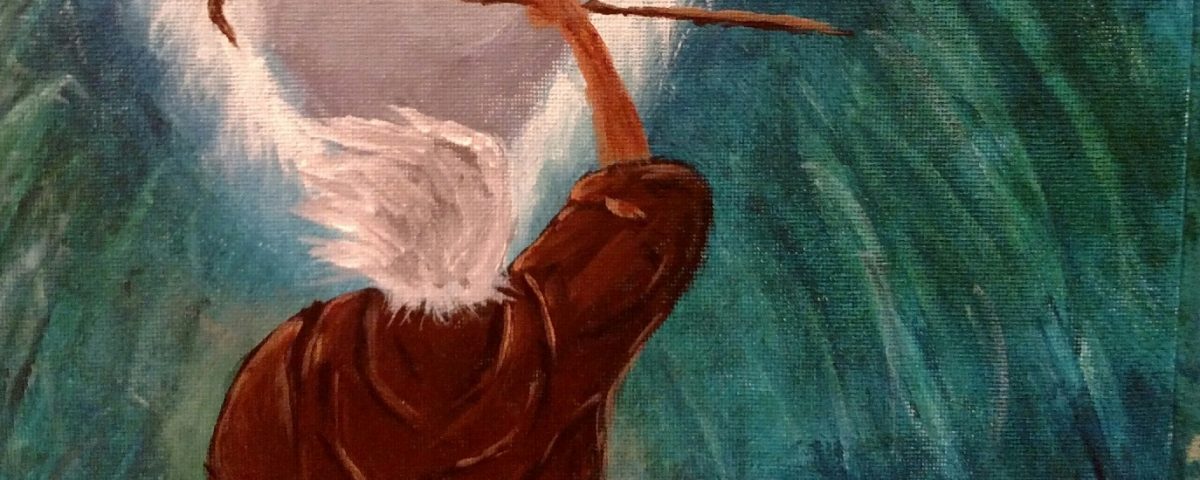
Jesus was High Priest from the womb!
July 12, 2021
Threefold Mystery
July 15, 2021Moses, a type of the one to come.

Jesus’ Transfiguration and the Believers’ Transformation: A Study of the Transfiguration and Its Development in Early Christian Writings By Simon S. Lee · 2009
First of all, in Jewish literature, Moses is remembered as God’s unique representative on earth, especially because of his experience of God’s Theophanic appearances in the Exodus stories. Moses’ encounter with God for the second tablets of the Torah in Exod 34 never stops being reinterpreted by later Jewish interpreters in various forms with multiple implications. It inspires those Jewish writers to emphasize Moses’ uniqueness as a mediator between God and Israel and to elevate him as “God’s beloved one” (Sir 45.1), “God’s chosen one” (Liv. Proph. 2.14-15), “God’s son” and “one like the Son of Man” of Dan 7 (Ezek. Trag. 96-100). It is at this event that Moses becomes the prophet par excellence (Sir 46.1) and is crowned king of Israel (Ezek. Trag. 96-100). Moses’ ascent on Mount Sinai is characterized as “heavenly ascent” (Sir 45.5; Bib. Ant. 12.1) and Mount Sinai becomes celebrated as the single most important place for God’s residence and special revelation.”[1]
Second, it is, however, more important for our purposes that Moses is claimed to experience glorious transformation in this event at Sinai. Interpreting the glory on the face of Moses in Exod 34, Philo in Mos. 1.158-59 describes Moses’ ascent at Sinai as a kind of mystical transformation. According to Philo, Moses enjoys God’s presence in the darkness where God was” and is initiated into the office as king (1.158-59), high priest (2.6771, 74, 75-76) and hierophant (Gig. 53-54).[2] Mos 2.70 reads, “he [Moses) descended with a countenance far more beautiful than when he ascended…the dazzling brightness that flashed from him like the rays of the sun.” For Philo, Moses’ transformation is somewhat similar to an apotheosis of divine men. In Quaest. in Exod, Moses is “changed (weteoposen) from an earthly man into the divine so that such men become kin to God and truly divine” (2.46 47: 2:29).[3] While Philo elevates Moses virtually to a second god, he still restricts Moses to the realm of human beings, thus making him remain within the sphere of divine men.[4] A similar claim for Moses’ divinization through the glorious transformation at Sinai is also attested to in Sir 45:2 and in Josephus (Ant 3.320).
Third, for Philo, it is because of Moses’ function as God’s spokesperson that he is allowed to experience the glorious transformation – he does not hesitate to link the splendor of Moses’ face with his office as lawgiver (Mos. 2.271). Similarly, Josephus claims that Moses is ranked “higher than his own [human nature” due to his intimate relationship to this “Law of God” (Ant. 3.320). The glory on the face of Moses is the very glory of God and the glory accompanies God’s offering of the Law in order to confirm the very divine origin of the Law. Furthermore, the glory legitimizes Moses’ authority as God’s mediatory agent of the lawgiver between Him and His people. In this sense, all the theophanic appearances of God in the Exodus stories may function to give Moses divine credentials for his mediatorial role as God’s representative on earth.[5] It is in obedience to Moses and his command that the judgment of God and the demonstration of Israel’s loyalty to God become manifest.
Fourth, in some Jewish writings, there seems to exist a parallel between Adam and Moses,[6] which is of special significance for our purposes in that it may illustrate a conceptual background for Paul’s Adam Christology (2 Cor 3 and 4; 1 Cor 15; Rom 3-5; Phil 2-3). According to Sirach, Adam “was glorified (locáoon) above every living thing in creation” (49:16) and was given “knowledge” as well as the law of life” (17:11). Sirach further claims that God established with Adam an eternal covenant and revealed to him His Glory and voice (17:12-13). In this line of thought, the first creation is God’s first enactment of the covenantal relationship with human beings by revealing both His Glory and the Law. Similarly, Sirach describes Moses and the Sinai covenant as follows: “God made him (Moses) equal in glory to the holy ones” (Sir 45:2): God also revealed to Moses His Glory (45:3) and the law of life and knowledge which was originally given to Adam at the creation (45:5); and God talked to Moses face to face, just as He did to Adam. For Sirach, Moses’ experience is exactly the reenactment of the first manifestation of God’s glory and the Law at the creation. In this sense, Moses’ encounter with God’s glory and his receiving of the Law can be seen as a second creation or new creation of His people.[7] However, the scripture attests that Adam’s disobedience along with the loss of the glory is followed by the recurring disobedience of the rebellious people of Israel in the wilderness[8] with the result that both Adam and Israel break the Law of God. As a result, the Hebrew Scripture promises “the New Covenant” (cf. Jer 31:31-33) in a future eschatological time.”[9]
For Philo, when Moses ascended Mount Sinai, becoming god and king, he saw the invisible God and His image in a vision, which is an incorporeal archetypal essence of existing things (Mos 1.1588). Moses was transformed into the image and became a paradigm for others to imitate. Philo also claims that this image is the Logos which Moses saw on Mount Sinai (Conf. 95-97). At Qumran, the faithful covenanters anticipate in their renewal of the covenant (1 QS 4:23; CD 3:20; I QH 17:15),[10] receiving the glory of God that Adam lost. Also in later Samaritan and Rabbinic materials, the light on the face of Moses is the primordial light of Adam. Furthermore, salvation is understood to be the restoration of the glory and the image that Adam lost and the messiah is expected to come with more glory than Adam (cf. Rom 1:23; 3:23: 2 Cor 4:4, 6).[11]
Fifth and finally, as I already mentioned above, Philo presents the transformed Moses after God’s image as a paradigm for others to imitate. According to Wayne Meeks, following Erwin R. Goodenough, this concept of transformative imitation is a common topos of the Hellenistic ideology of kingship. The predominant Hellenistic ideology of kingship viewed the ideal king as a personal presence in unwritten universal law.”[12] Human beings’ transformation modeled after their transformed leader is, however, well attested in Qumran literature.[13] As is well known, the Qumran community applies the Exodus imagery to themselves with the result that their leader, the righteous teacher, takes up the role of Moses.
In the Thanksgiving Psalms, God causes His light to shine on the face of the righteous teacher and in turn, his illumined face causes the faces of the many to shine (1 QH 7:6-25; 2:1-19; 2:31-39; 4:5-5:4).[14] The illumination of their faces also affects their hearts, so that the community who believes to live in the New Covenant of Jer 31:31 (CD 6:19; 1 QpHab 2) comes to acquire a renewed understanding of the Mosaic Covenant of Old (1 QS 5:7-9). The language of shining, light/glory, covenant and the Law is clearly reminiscent of Exod 34:28-35 and is powerful evidence of ongoing Jewish exegetical traditions about Moses’ transformation at Sinai. In the following exegetical analysis of 2 Cor 3, I will show how these Mosaic traditions reappear in order to help Paul defend his ministry of the New Covenant, especially through the idea of the Corinthians’ glorious transformation as the divine credential for his genuine apostleship.
[1] I am borrowing these references from A.D.A. Moses, Matthew’s Transfiguration Story and Jewish-Christian Controversy, 61-78.
[2] Moses, Matthew’s Transfiguration, 52.
[3] Meeks, 123; and J. Jeremias, “Moses,” in TDNT (1967), 850. Although the concept of the divine men has been debated a lot, I think that in that time period, there exists at least a certain pattern of divine men, if not a concrete definition of it. For more on this debate, refer to ch.1.
[4] Meeks, 102.
[5] See also, Hafemann, 197; and Newman, 244.
[6] Cf. 1 Enoch 89:44-45.
[7] Hafemann, 433; and Newman, 111-12, 225.
[8] There is an ongoing Jewish tradition that Israelites could not see the Glory on the face of Moses due to their sin of making a golden calf. This idea is again connected to Adam, who after the Fall was not able to talk to God face to face, because he could not stand God’s glory. See Belleville, 66; and cf. Hafemann, 371.
[9] It is not surprising that Paul is well aware of this line of thought, so that he presents the covenant on the basis of Jesus Christ’ death as the promised new covenant of Jeremiah.
[10] I borrow these examples from Meeks, 105. Also for the bibliographical information on this topic and for further Jewish references, see Newman, 225.
[11] For this discussion on the issue of glory in the Samaritan and Rabbinic materials, see Dunn, 100-5; Meeks, 176-285; Belleville, 48-52, 63-72; and Moses, 66-73.
[12] Meeks, 110-11; Erwin R. Goodenough, By Light, Light: The Mystic Gospel of Hellenistic Judaism (New Haven: Yale University Press, 1935); and Erwin R. Goodenough, “The Political philosophy of Hellenistic Kingship,” in Yale Classical Studies, ed. Austin M. Harmon (New Haven: Yale University Press, 1928).
[13] Fitzmyer, “Glory Reflected on the Face of Christ (2 Cor 3.7-4.6) and a Palestine Jewish Motif,” 630-44; and Belleville, Reflections of Glory, 44-47.
[14] For more references and their analyses, see Fitzmyer, 639-44.
